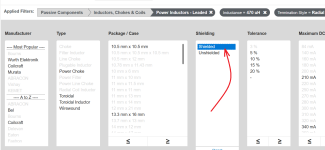PSRR:
10kHz - 110dB ...previous 49dB
That is a big difference!
Perhaps you may wish to study the PSRR of "UDP3" -- Umbilical cable Driver for Pearl 3 phonostage --- here on these Forums. You'll see that the PSRR of UDP3 is amazingly better, partly because it includes an LCR lowpass filter (overdamped!), in addition to some wide bandwidth active crud cutters. Phonostages for moving coil cartridges require very low noise power supplies, and UDP3 is an attempt to provide them. If you are tempted to experiment with LCR filters like this one, be sure to click the "Parametric Search" option indicated below.
UDP3 schematic (here) .
_
Attachments
Last edited:
Improving ripple rejection by passive components R C R L has the great advantage of doing so with no impact on stabilty.
To honestly compare PSRR one should consider designs or topologies at same stability. A simple way to see stabilty is to look at the output: The ringing when fast loading/unloading is a signature of the instability.
The second best with no impact on stability is a CCS feeding a voltage reference. A large dynamic resistance ( like 10 MegOhm ) feeding a small dynamic resistance ( like 10 Ohm ), gives an immediat -120dB. But beware of indirect impedances sneaking in.
Of course active circuitry can improve PSSR as much as one likes, by means of loop gain, up to..... Stabilty is lost.
To honestly compare PSRR one should consider designs or topologies at same stability. A simple way to see stabilty is to look at the output: The ringing when fast loading/unloading is a signature of the instability.
The second best with no impact on stability is a CCS feeding a voltage reference. A large dynamic resistance ( like 10 MegOhm ) feeding a small dynamic resistance ( like 10 Ohm ), gives an immediat -120dB. But beware of indirect impedances sneaking in.
Of course active circuitry can improve PSSR as much as one likes, by means of loop gain, up to..... Stabilty is lost.
Do not confuse supply noise voltage with noise spectral density.
In the diagram above LNA noise output with inputs shorted is 58 nV.
In the diagram above LNA noise output with inputs shorted is 58 nV.
Do not confuse total noise over specified bandwidth with value at specific frequency (FFT bin). 🙂
We can reliably measure, in example, 100 Hz ripple voltage to below 1 nV levels.
If money is no object(ion), you can use this: https://www.tek.com/en/products/kei...ecialty-instruments/nanovoltmeter-model-2182a
Still, no cigar (for 1 nV at specific frequency).
We can reliably measure, in example, 100 Hz ripple voltage to below 1 nV levels.
If money is no object(ion), you can use this: https://www.tek.com/en/products/kei...ecialty-instruments/nanovoltmeter-model-2182a
Still, no cigar (for 1 nV at specific frequency).
I might continue measure some data of the PSRR.Continue measuring. This is what brought us here. please continue
My circuit is not bad, but there are better regulators.
The circuit is however as simple as it get.
Can you enclose the asc files for LTSpice?I took the liberty of doing some sims of a slightly modified circuit. Replaced the 1K5 resistor with a constant current source and the LM329 with back to back zeners.
Load-line regulation
View attachment 1213895
PSRR
View attachment 1213896
Output impedance
View attachment 1213897
View attachment 1213898
Noise
View attachment 1213899
- Home
- Amplifiers
- Power Supplies
- Discrete Regulators +/-15V with good performance
